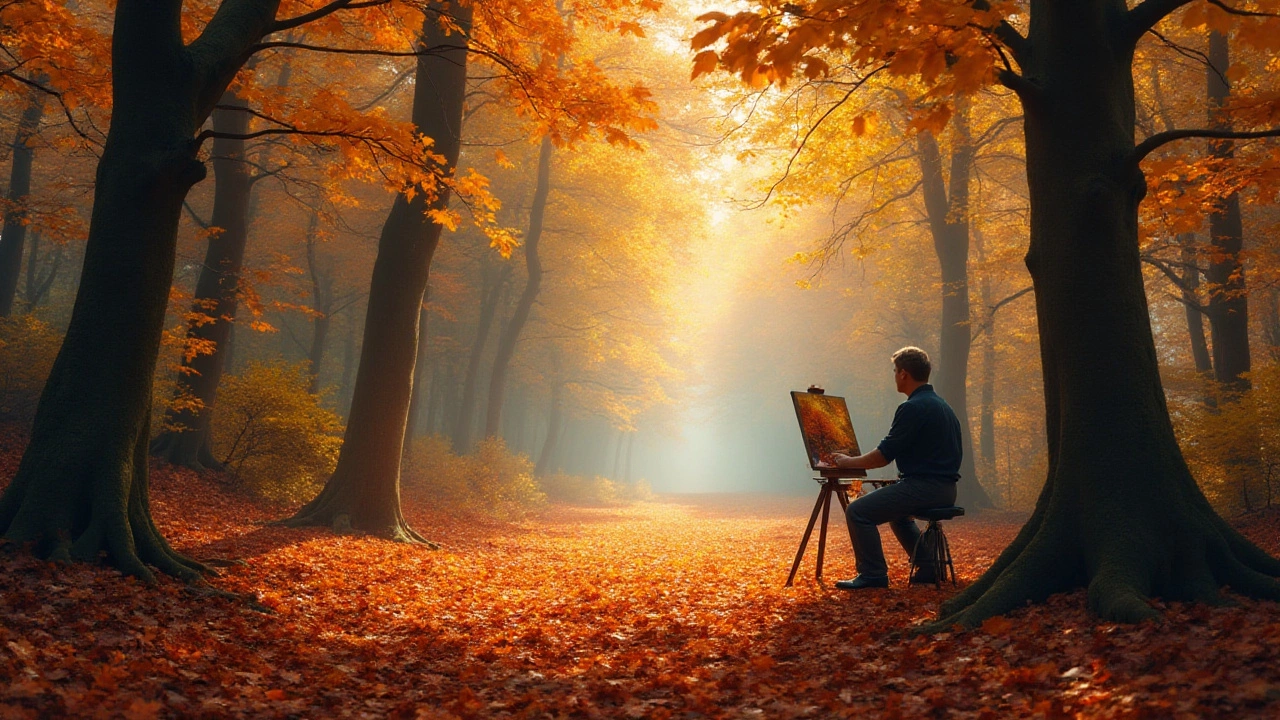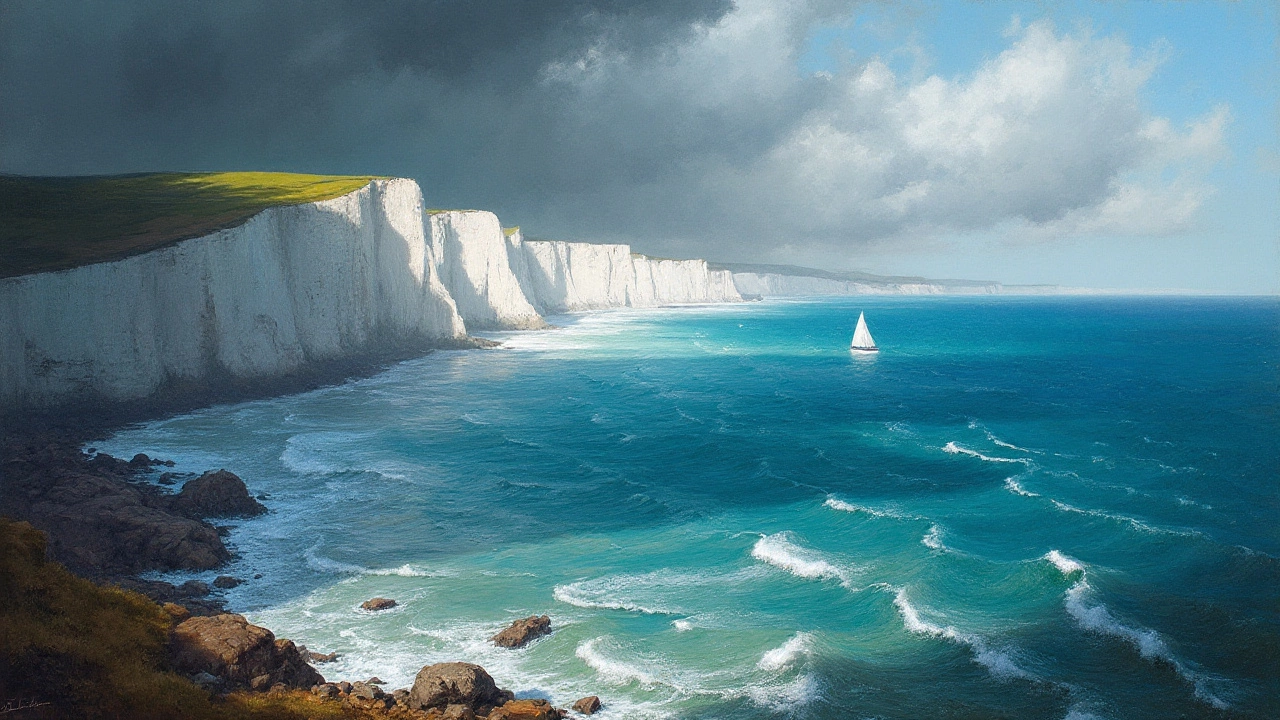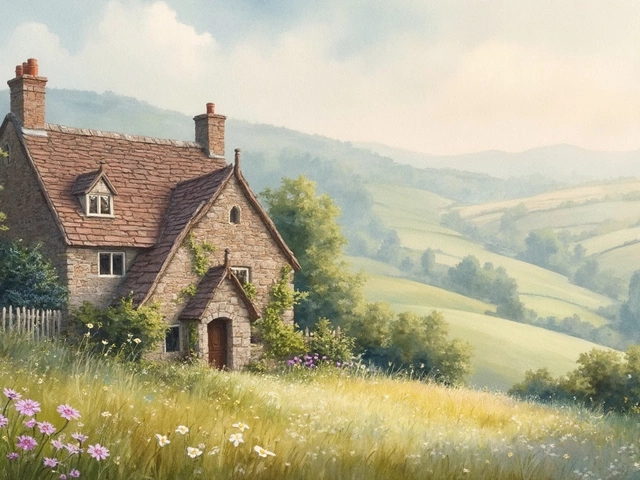Embarking on the journey of painting a landscape is akin to stepping into a world where colors breathe life. Each stroke on the canvas captures a piece of nature's grandeur, inviting viewers to lose themselves in the beauty of the scene. Yet, as any artist knows, achieving that sense of balance and harmony requires more than mere inspiration—it's about technique and strategic planning.
When facing a blank canvas, one of the first considerations should be the sequence in which elements are painted. This sequence can shape the depth, focus, and mood of the entire piece. Should you begin with sweeping skies or start with intricate details? How do you prioritize the elements without losing sight of the bigger picture?
In this exploration, we'll delve into essential techniques that guide artists in painting landscapes. We'll uncover how the canvas can turn into a vibrant world by establishing a focal point, layering elements thoughtfully, and understanding the interplay of light and shadow. These insights will provide guidance to both budding and seasoned painters aiming to enhance their skills in landscape artistry.
- The Importance of Planning
- Choosing a Focal Point
- Establishing the Horizon Line
- Understanding Light and Shadow
- Layering Background and Foreground
- Refining Details Last
The Importance of Planning
In the realm of landscape painting, the foundation of a successful masterpiece often lies in the elusive art of planning. Although spontaneity plays a role in creativity, meticulous planning ensures that each brushstroke contributes to the overall vision. Without forethought, artists might find themselves entangled in mistakes or lost in a disorganized composition where beauty becomes overshadowed by chaos. Planning a landscape involves imagining the final piece in your mind before the brush even touches the canvas; it's seeing the end from the beginning.
One critical step in the planning process is choosing the scene's focal point. Determining this early on helps guide the composition and keep the artist's efforts focused. This aspect cannot be overlooked, as a well-chosen focal point has the power to draw the viewer's eyes and hold their attention, acting as the anchor of the artwork. By settling on this element early, artists can manage the flow and balance of the piece effectively, leading to a harmonious exchange between different components of the painting.
"The aim of art is to represent not the outward appearance of things, but their inward significance," said Aristotle. This idea emphasizes the significance of planning in capturing essence rather than mere likeness.
Another essential consideration is how light and shadow will interplay across the landscape. The direction of light affects the mood and drama of a painting. By understanding this in the early stages, artists can allocate space for light to illuminate particular features, creating depth and realism. Planning light influences not just aesthetics but also the pacing of visual storytelling within a painting. A stunning sunrise, for example, might demand a different handling compared to the languid shadows of late afternoon.
Strategy in Sketching
Sketching becomes an indispensable tool during the planning phase. Preliminary sketches allow artists to experiment with forms and lines, making adjustments before investing in the painting itself. Sketches serve as blueprints, helping refine ideas and identify potential issues. These can be simple outlines that map out major elements or detailed drawings that explore textures and lighting. Through sketches, the complexities of the real world give way to simplification, providing clarity and coherence.
Utilizing a painting technique plan also provides a framework for complex landscapes featuring various elements such as trees, water bodies, mountains, or plains. This endeavor might involve creating a list or mental map of each element's placement and the sequence of their application. Artists can think about color palettes, materials, and even the mood they wish to evoke. All these decisions act as the threads weaving together an intricate tapestry.
| Step | Action | Purpose |
|---|---|---|
| 1 | Choose Focal Point | Focus viewer's attention |
| 2 | Sketch Initial Design | Preliminary idea refinement |
| 3 | Determine Light Source | Influence mood and depth |
| 4 | Palette Selection | Set color tone and harmony |
Planning is not about restricting creativity; rather, it is a guide that directs it. The act of touching the canvas should be informed by contemplation and vision. While impromptu adjustments will naturally occur, a well-conceived plan provides the confidence to explore and experiment. Thus, an artist's best work often arises when their intuitive impulses are structured by purposeful planning, leading to the realization that the process is as vital as the final image. With strategic design and clarity of intention, a landscape painting transcends visual representation to become an authentic expression of nature's beauty on canvas.
Choosing a Focal Point
Imagine standing at the edge of a breathtaking vista, all elements rushing towards your senses in a glorious symphony of nature. When painting a landscape, capturing this essence often centers around identifying and emphasizing a focal point. This area of your canvas draws the viewer's eye, holding them in its grip long enough to tell a story. In the intricacy of landscape painting tips, the focal point acts not just as the heart of your artwork but the anchor that balances all other parts.
Determining what that focal point should be can influence the impression and emotion your painting conveys. Consider Claude Monet, whose works like the "Water Lilies" series, display mastery in guiding attention seamlessly through the canvas. Monet's ability to choose focal points within his environmental compositions is what gives his paintings a hypnotic quality, subtly demanding attention in every brush stroke. Key to this technique is deciding whether your landscape's focus will lie in the natural features, like a cluster of blooming trees, a vast mountain, or the interplay of light over a tranquil lake.
To decide on a focal point effectively, consider what element of your landscape is most striking or tells the most compelling story. Picture a painting centering its focus on a lone windmill amidst a sprawling field. This choice immediately speaks to themes of solitude, industry against nature, or the passage of time, allowing the viewer to connect intellectually and emotionally.
"A landscape painting is essentially a place where man and nature meet," says Andrew Wyeth, an iconic realist painter who utilizes focal points to evoke poetic longing.Your focus doesn't always have to be detailed or centrally located—it could be the distant silhouette of a city at dusk or a bold splash of color that contrasts against a muted background.
When you settle on a focal point, the interplay with surrounding elements is crucial. You must ensure there's harmony that leads the gaze to and from this point naturally. Some classic ways to enhance the focal point involve adjusting the scale, contrast, or the sharpness of the particular area. In terms of techniques, softer lines and less vivid colors can be used in surrounding areas to prevent competition for attention. Drawing from established concepts of art composition, a well-placed focal point will play an undeniable role in the success of any beginner artist guide aiming to create impactful art.
If we delve a bit deeper, some artists use perspective lines that guide the viewer's eye directly toward the focal feature. This intentional design can be constructed through natural elements, such as pathways, rivers, or rows of trees. Artists today and in times of the past know that a deliberate focal point can act as a fulcrum for conveying deeper narratives within a visual story. Remember, whether your focal point is a humble cottage tucked away in greenery or an explosive sunset bursting with color, it holds the power to dictate the flow and emotional resonance of your landscape painting.

Establishing the Horizon Line
In the world of landscape painting, the horizon line serves as a silent anchor. It's where the sky meets the land or sea, quietly organizing the chaos of nature into a harmonious scene. For artists, setting this line on the canvas is one of the most crucial steps, as it dictates not just the viewpoint and perspective but also the emotional tone of the painting. An elevated horizon might give the viewer a god-like, sweeping view of the landscape, while a lower horizon often magnifies the sky, engulfing the spectator in the vastness above.
Interestingly, the horizon line plays a significant role in creating depth and balance within a painting. It allows artists to manipulate how the viewer's eye travels across the canvas. When placed thoughtfully, it can enhance the composition's perspective, offering a sense of dimension that makes a flat surface appear incredibly three-dimensional. This technique has been utilized by masters since the days of Titian and Vermeer, who intricately wove their subjects around this powerful, invisible guide.
Any budding artist might wonder how to decide where exactly to place the horizon. A practical approach involves gauging the emotional impact one wants to convey. Will the piece exude tranquility with a sky-dominated canvas, or is it more about the land's richness, which would benefit from a lower sky? These questions are not just technical. They're deeply intuitive and personal, molding the narrative of the landscape painting. The horizon line should serve the story the artist intends to tell, a decision echoed in the words of the celebrated painter Claude Monet:
"For me, a landscape does not exist in its own right, since its appearance changes at every moment; but the surrounding atmosphere brings it to life, the air and the light which vary continually."Here's a tangible look at how horizon placements can affect the viewer's perception, shown in a table:
| Horizon Placement | Effect on Composition |
|---|---|
| Low Horizon | Emphasizes sky; conveys openness and freedom. |
| Center Horizon | Balanced view of both sky and land; promotes stability. |
| High Horizon | Highlights land details; creates a more intimate or grounded feeling. |
Artists must also consider the horizon's function in controlling the painting's depth and structure. By strategically placing it, they can define the spatial relationships between various objects, ensuring that elements like trees, mountains, and rivers fall naturally into place, rather than seeming scattered or lost. These tips and techniques are invaluable for any painter looking to hone their skills. Understanding and implementing these concepts not only refines one's painting techniques but ensures that every stroke contributes toward building the painted world.
Understanding Light and Shadow
In landscape painting, light and shadow are the silent artists that bring depth and dimension to your work. It’s through these elements that a flat canvas transforms into a world filled with volume and emotion. The play of light across different surfaces can evoke myriad feelings—serenity during sunrise, the energy of midday, or the haunting allure of twilight. Understanding how to depict light and shadow accurately is crucial for anyone looking to master landscape painting techniques.
At the heart of capturing light effectively is the recognition of its source and direction. Where is the light coming from, and how does it interact with the landscape? This understanding helps in predicting the cast of shadows and highlights. Shadows aren't always gray or black; they carry hints of the colors of the objects casting them, influenced by surrounding hues. It's fascinating to note that shadows can often be warmer in the morning and cooler during the afternoon, as the angle and warmth of the sunlight change.
Understanding light means also grasping its intensity across different times of the day, a subtle art in its own right. Morning and evening lights are softer and can cast long, dramatic shadows, while midday sun can be harsh with fewer shadows but more vivid colors. As Claude Monet once observed, "Color is my day-long obsession, joy, and torment." His studies of light—how it danced across water lilies or shimmered on cathedral walls—offer invaluable lessons for contemporary artists striving to harness the effects of light.
“To paint is to know how to paint with all that’s available to you.” — Claude Monet
The manner in which light falls on a tree might highlight its boughs while leaving the leaves in shadow. This intricacy adds dimension and realism to landscapes, a skill prized even by seasoned painters. Simulating such play might require layering different textures and tones, ensuring a harmonious flow between background and foreground, capturing the true essence of a landscape.
One way to practice these concepts is by sketching studies at various times of the day. Note how the shift from morning to afternoon impacts shadow length and angle, and how artificial lights during the night differ from natural sunlight. Some artists find success in creating a series of quick studies, focusing intensely on a single aspect—like the way tree branches stand stark against an early evening sky, a testament to the dual nature of shadow assisting in portraying the three-dimensional world on a two-dimensional canvas.
Finally, a beginner artist guide to shadow is not complete without emphasizing practice. Observe, sketch, and experiment, for it’s through repetition that an artist learns the subtle art of light and shadow. These elements, often overlooked, are profound tools that can turn an ordinary painting into an extraordinary one, ensuring that your landscape vividly reflects the spirit it intends to capture.

Layering Background and Foreground
In the realm of landscape painting, grasping the concept of depth is crucial to portraying a scene that resonates. This is where the meticulous practice of layering the background and foreground comes into play. The way these elements are orchestrated can drastically influence the viewer's perception and emotional response. Painters typically start with the background before advancing to the foreground, allowing each layer to build upon the last. This practice not only establishes perspective but also maintains balance within the scene.
Beginning with the background, artists often utilize broad strokes and lighter tones to create an expansive sense of distance. The background sets the stage, acting as the canvas upon which the rest of the painting is built. Many artists, like the legendary John Constable, suggest starting with the sky, as it is a significant element in setting the painting's mood. This backdrop should remain less detailed, encouraging the eye to wander naturally to the more intricate foreground. A well-blended sky or distant horizon subtly frames the central narrative of a landscape painting.
As the artist progresses to the middle ground, integrating more details becomes essential to bridge the gap between the serene background and the vivid foreground. Here, elements like hills, trees, or water bodies are defined with sharper contrasts and more varied hues. Utilizing techniques such as aerial perspective, where the use of cooler and less intense colors suggest distance, can also add significant depth. This mimics how our eyes perceive vistas in the real world, adding authenticity to the painting.
Venturing into the foreground requires a shift in technique and focus. The foreground often contains the most intricate details and vibrant colors, drawing the viewer’s eyes instantly. The meticulous depiction of elements, such as textured rocks, lush foliage, or detailed structures, provides a tactile quality to the painting, inviting viewers to linger. To enhance these features, artists often use techniques like glazing, which involves laying semi-transparent paint layers that enrich the scene's color and luminosity. As Vincent van Gogh once said,
"Great things are not done by impulse, but by a series of small things brought together."This is particularly true in layering painting methods, where patience and precision create depth and harmony.
Understanding how light affects each layer further enriches the painting. Observing how shadows play against surfaces at different times of the day can add realism and drama to the composition. Light seems to wrap around objects, casting shadows that provide form and structure. This observed interaction is paramount for conveying the natural beauty and complexity of a landscape. To achieve this, experimenting with light sources and shadow techniques in preliminary sketches or studies can prove invaluable.
In essence, mastering the techniques of layering serves as the backbone of compelling landscape art, transforming a flat surface into a window of realism and emotion. It requires a refined balance of knowledge, technique, and creative intuition. Such skill can captivate an audience, transporting them to the heart of the painted world with just a glance.
Refining Details Last
Finishing a landscape painting is a gratifying pursuit, yet it demands attention and precision when it comes to perfecting the finer details. It is essential to save the meticulous aspects for the end, as earlier stages of a painting are dedicated to shaping and defining the broader picture. As the finishing touches are applied, the painting shifts from a collection of abstract forms to a cohesive portrayal of nature's vivid scenes. This strategy not only preserves the integrity of the painting techniques but also affords the artist the freedom to adjust the composition until it meets their vision.
One of the reasons for leaving the details until the end lies in the interplay between light and texture. Once the foundational elements of light and shadow have been anchored, artists can then accurately introduce details like the sparkle of sunlight on water or the intricacies in tree bark. Techniques such as glazing, which involves painting thin layers of translucent color, allow artists to adjust the color and luminance in realistic ways. This stage is where the painting comes alive, where each highlight and shadow is a deliberate stroke, signifying movement, mood, and depth. As renowned artist John Ruskin once said,
"The highest reward for a person’s toil is not what they get for it, but what they become by it."Ensuring that the details enhance rather than overshadow the bigger picture helps maintain this sense of balance and reward in artistry.
Detailing also touches on the intricate patterns found in landscapes, such as the delicate fronds in a field of wildflowers or the contour lines of distant hills. These elements, often small in comparison to the overarching composition, can hold the key to drawing a viewer's eye across the painting. Artists working on these smaller parts must consider how these lines and textures echo the grander themes within their work, ensuring that even the smallest line contributes to the story told on the canvas. By leaving these tasks for last, they acknowledge that detail serves as a complement—never a distraction—to the core composition.
An advisable approach to detailing is to step back frequently, viewing the painting from a distance to ensure cohesion. From afar, the interaction between each element becomes clearer, allowing for adjustments in contrast and color saturation to unify the piece. A varied approach, switching between different brush sizes and pressures, can also help in transitioning smoothly between bold landforms and the subtle textures of nature. In this pursuit, a seasoned artist becomes as much a part of the landscape they paint as the paint itself, adapting and reacting to the evolving image.
In refining details, implementing texture through various mediums can enhance the realism and tactile quality of a landscape. Artists often utilize impasto or textured gels to integrate physical texture, which can serve as the final flourish that elevates a painting's dynamic quality. These textural enhancements, coupled with the precise use of vibrant or muted colors strategically placed in detailed sections, can bring an intense vibrance and authenticity to the representation of natural settings. Yet, too much focus on these elements can overshadow the initial vision, so balance remains paramount.
The ultimate goal of refining details last is to align the painting closely with the artist’s initial inspiration. This stage allows final adjustments that can amplify or quiet certain aspects to match the scene's true essence. It invites the artist to infuse personal touches, from signature brushstrokes to unique palettes, which ultimately animate the vision. When executed with patience and intention, the final details create a dialogue between the artwork and its audience, where each viewer might discover their own connection to the landscape’s beauty.



